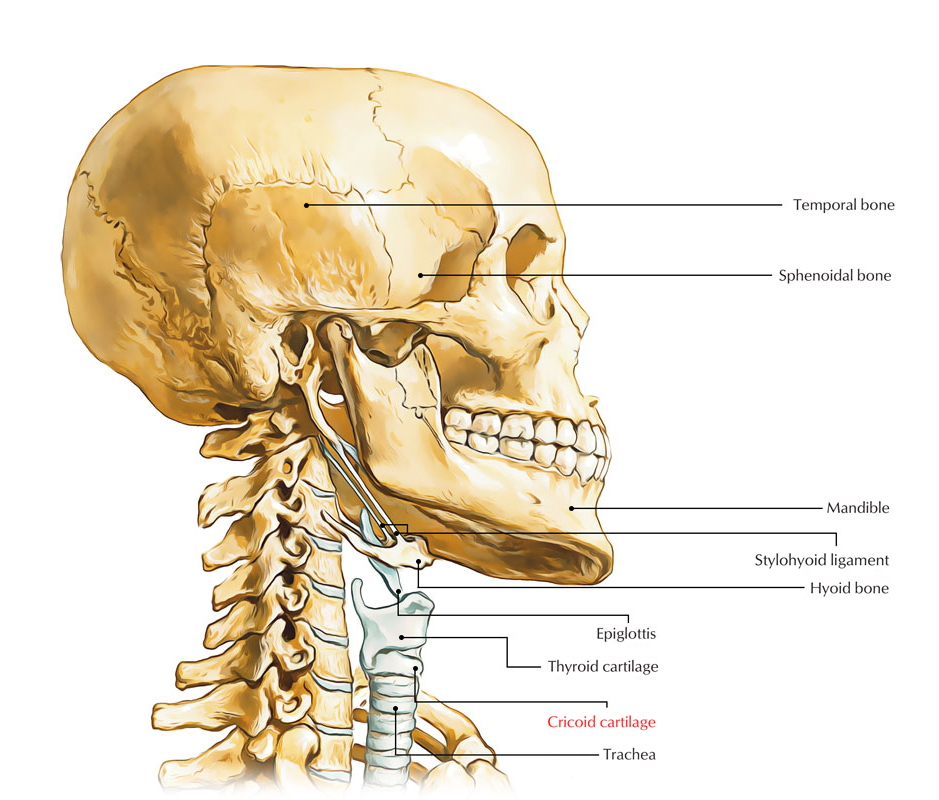The only complete ring of cartilage around the trachea is the cricoid cartilage or cricoid ring. It creates the posterior part of the voice box and functions as an attachment site for muscles, cartilages, as well as ligaments associated with opening and closing the airway and in creating speech.

Cricoid Cartilage
Structure
The anterior portion is known as the arch and the posterior quadrangular shaped portion is known as the lamina. It creates a joint with the thyroid and arytenoid cartilages via synovial joints.
- A vertical rim with shallow indentations is found there the midline of the lamina in order to attach with each side of the posterior cricoarytenoid muscle.
- The cricoid cartilage connects:
- Towards the thyroid cartilage via the median cricothyroid ligament.
- Towards the first tracheal ring via the cricotracheal ligament.
The posterior surface of the lamina is defined via two shallow oval indentations divided via a perpendicular rim.
- The esophagus connects with the ridge and the indentations are to connect with the posterior cricoarytenoid muscles.
- The cricoid cartilage has two articular parts on each side in order to form a joint with other laryngeal cartilages:
- One part connects with the base of an arytenoid cartilage and is located on the inclined superolateral surface of the lamina.
- Other part joins with the medial surface of the inferior horn of the thyroid cartilage and is on the lateral side of the lamina around its base.
Relations
- Descendens hypoglossi or upper root of ansa cervicalis emerges as the nerve travels anterior towards the internal carotid artery. In order to join the inferior root of ansa cervicalis it travels downward at the level of cricoid cartilage.
- Level III terminal cervical lymph nodes spread outwards from inferior border of level II towards the cricoid cartilage.
- Thyroid cartilage is located superior towards cricoid cartilage.
- Tracheal rings are located below cricoid cartilage.
- The thyroid glands two lobes extend over on either side of the cricoid.
- Attachment of pretracheal fascia towards hyoid bone and thyroid and cricoid cartilages, at the time of ingesting enables the thyroid gland in order to move up and down with the larynx.
- Ligament of Berry originates from pretracheal fascia and connects the capsule of the lateral lobe of the thyroid gland and the cricoid cartilage.
- The esophagus starts at the inferior margin of the cricoid cartilage opposite to vertebra CVI.
- Inferior constrictor muscle anteriorly attaches to cricoid cartilage.
- At the superolateral surface of the lamina of cricoid cartilage, the concave base of arytenoid cartilage creates a joint with the inclined articular facet.
- The cricotracheal ligament travels from the lower boundary of the cricoid cartilage towards the adjacent upper margin of the first tracheal cartilage.
Functions
- Cricoid cartilage gives attachment to various ligaments, cartilages, and muscles related to closing and opening of the airways and production of speech.
- Cricoid cartilage creates a covering over the ends of the bone joints.
- It gives smoothness and flexibility to the joints.
Clinical Significance
Brachial Plexus Block
At the level of cricoid cartilage, brachial plexus in the posterior triangle is located inferior towards the line continuing from the posterior margin of the sternocleidomastoid towards the middle on the superior portion of the clavicle. This block creates anesthetic effects.
Cricoidectomy
A medical procedure known as a cricoidectomy is carried out in which a part or the whole cricoid cartilage is eliminated. This is generally performed in order to relieve blockages within the trachea.
Emergency Airway Puncture or Cricothyrotomy
When other procedures fail in order to recover the respiratory disorder of the patient, during severe respiratory problems, Emergency Airway Puncture or Cricothyrotomy is carried out for helping the patient in breathing when a hollow needle is inserted inside the cartilage.

 (51 votes, average: 4.45 out of 5)
(51 votes, average: 4.45 out of 5)